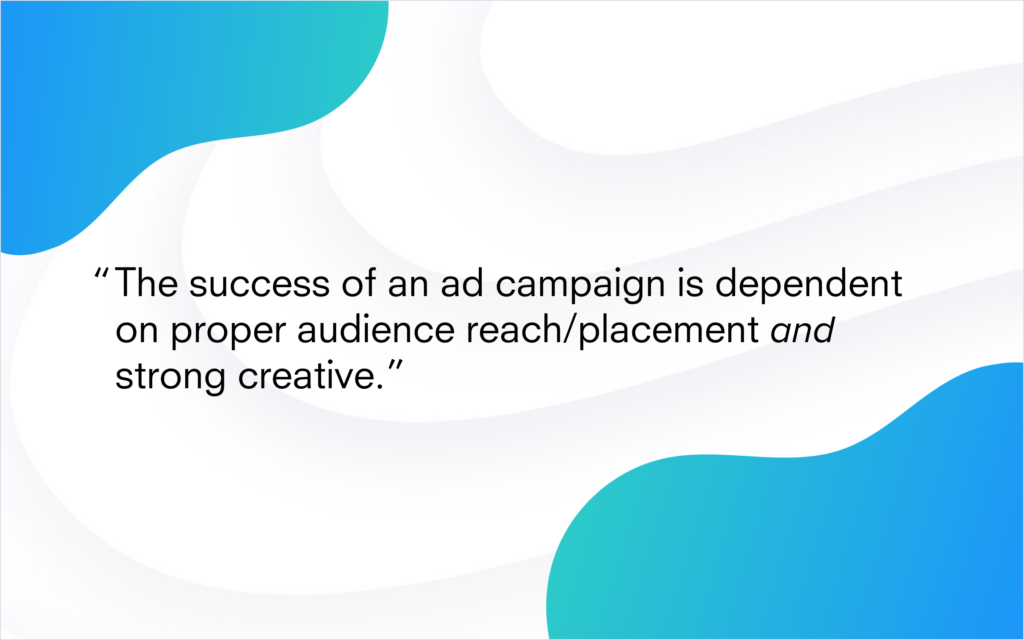Ever see an ad, whether video or static, and think to yourself: what is it trying to tell me? What is the brand? What does this brand do? As marketers, we know the importance of placing an ad in front of the right audience, but not enough attention gets paid to the strength of the creative and if it is aligned with the goal of the advertiser: whether it be awareness, consideration, a purchase goal, or an entirely different goal altogether.
One thing we’ve seen at Quantcast is that it is important to remember that the success of an ad campaign is dependent on proper audience reach/placement and strong creative. While we are experts on audiences, we also realized there was a need to make sure strong creative messaging was part of the equation. We began assisting clients with their creatives and have found it to be beneficial in helping to improve performance, which is everyone’s goal.
The first step toward better digital creative is to align the creative messaging with campaign objectives. This sounds simple, but it is one of the most frequently missed opportunities in ad campaigns.

Awareness Campaigns
Awareness campaigns aim to reach customers to familiarize them with a brand or let them know a product exists. If it is a new brand or product, companies are using awareness campaigns to introduce its name and concept. For an existing brand, they may have a new product or a line extension they want to educate the customer on. And sometimes, an advertiser may want to spread awareness about a specific topic relevant to the brand.
To solidify brand awareness in creatives, it’s important to make sure your branding is clear and your messaging represents your goals. Make sure your logo is visually easy to spot on every ad, even on native ads or videos.
Leading with Logo: The Do’s
- In traditionally static or rich media display ads, your logo is clearly visible. If your logo does not have a clear brand name in it, then make sure the brand name is also highlighted.
- When the brand logo isn’t used, your brand name is emphasized. For native ads, we know customers purposely don’t want their brand logo in the ad, but it is important to make sure that your brand name pops if you are trying to drive awareness of the brand.
- In video, your logo is visible in the beginning, middle, and end of the ad. It is important to make sure that the logo is present and also visible and not blocked by ad components like the video controls.
- In all formats, a measurement strategy is set up to align with your campaign goals. Therefore, if you are trying to measure awareness, the best ways to do that are either via an awareness study or search term measurement.
(Not) Leading with Logo: The Don’ts
- Logo is only visible in the last frame of a 15s or 30s video. Not everyone will watch until the end, so you want to make sure your brand is viewable by even those who don’t complete the video. I’ve seen a brand only feature their logo at the end of a 30s video, and upon running an ad campaign, they wanted to know why the video didn’t drive awareness. We looked at the video completion rate (VCR) and noticed that it was only 50%, which meant that half of their audience didn’t get to the part where the logo was displayed. When we recommended adding a small logo to each video frame, awareness numbers increased significantly.
- Brand name is unreadable in your logo. We recently ran an ad campaign for a cooking-related brand whose branded logo was the initials of the brand name and was featured on a chef’s hat in every video scene. Nowhere else in the video was there a brand name printed, until the very end of the vignette, but again, not everyone pays close attention to the end of a video. We recommended they add a logo with the full brand name in every scene, which drove much stronger results in a post-campaign awareness study.
- Video content is not relevant to the awareness you are trying to drive. For example, we had an advertiser provide visually impactful content that spelled out the brand and its features beautifully. However, it was product awareness and not brand awareness they were trying to drive–and therefore, when they measured their objective and asked consumers if they were familiar with the new product’s name, the answer was “no.” Since the creative featured the brand name and a picture of the product but no product name, product awareness performed very poorly. When the product name was added to the creative, the advertiser saw much stronger results.
Consideration Campaigns
Consideration campaigns are mid-funnel campaigns aimed at convincing consumers to take action regarding a brand. Therefore, a strong campaign talks about the benefits of a product or brand:
- Make sure you feature compelling attributes about the product to help with consideration. For example, an automotive client gave us a creative that only showed a car and a potential customer with the logo of the brand on it. Another creative from the client again showed a car and a potential buyer but it added a tagline promoting home delivery and the largest selection of autos in the country. When we reviewed these ads with the client, we determined that their true goal was more mid-funnel than upper-funnel, and so we recommended they run with the creative that featured the reasons to consider the brand. As a result, the campaign performed very well on its consideration question.
- Remember that consideration campaigns are not direct response (DR) campaigns. Moving customers through the purchase funnel means making sure a consumer is aware of the key benefits of your brand when they are in the market for the product. However, this doesn’t mean they will make an immediate purchase. The most common mistake here is measurement. Though we are promoting attributes of a brand, the best measurement here is either a brand study or a search term measurement. Some consideration campaigns do drive site visitation, but many times those are products that involve research, and typically those site visits are not from customers who click on your ads.
Conversion-Driving (Direct Response) Campaigns
Ultimately, the goal of most marketers is to drive a sale. However, it is rare for a customer to convert after only seeing one conversion-driving campaign and make a purchase without an awareness and consideration campaign as well. Sometimes the succession of these campaigns can span weeks, months, or even years, across different media and placement types.
The best suggestion for measuring these types of campaigns are:
- Stop counting only click conversions. Because of the nature of display advertising, it is rare for someone who is seeing a display campaign to stop the activity they are doing and immediately convert or even click on a creative. The best way to measure conversions is by tracking view-through conversions, with a customized lookback period based on the client.
- Determine the proper lookback period. Different industries and product lines have varying influence windows, called lookback windows, during which one should attribute or give credit for the conversion to a particular ad placement. If we think about a consumable item such as gum, for a brand that is already a household name, it might be a shorter window to conversions, maybe 7-14 days. However, when considering an item like a car, the purchasing process requires a lot of research; people are researching what brand and type of car they need next, even before they are ready to buy. Therefore, a much longer lookback period is required, sometimes up to 90 days or longer.
- Stop using last-touch attribution. Just because a placement was the last touch for the customer, does that mean that was the only influence on the purchase? Using this methodology, both search and retargeters get all the credit, but in many cases, a purchase has been determined before those ad placements are even viewed. There are three methodologies we recommend for measuring the impact of your brand:
- Incrementality: the comparison of two audiences, one who has seen your media and one who hasn’t, to determine the impact of the campaign and whether it is driving conversions that wouldn’t have happened anyway. This is something we have spent a lot of time promoting internally at Quantcast, and we run our own incrementality test for clients who want to understand the lift. These campaign tests should only be run on action-driven campaigns such as conversions, leads, or site visits.
- Multi-Touch Attribution: this is where a client or a third party looks at the individual spend and all those touchpoints present before a conversion occurs, so that they can assign a weight to each touchpoint that is seen to play a role in the conversion.
- Media Mix Modeling: this is a third-party aggregate view approach, which looks at overall spend and overall results. The goal of this approach is to try to understand the impact of each marketing channel’s spend on the results.
The Full Funnel Works Together
Using the above campaign types together works significantly better than using them individually in silos. Combining the awareness, consideration, and conversion-driving campaigns yields the best conversion rates and highest revenue for most clients. However, that is only true if creatives are designed with the goals of each campaign type in mind. Serving the right audience with creatives is not enough. Creatives need to be tailored to their specific role in the funnel for the best results for a client. Having a strong audience without a strong objective driving creatives doesn’t work on its own. Having great creatives without a relevant audience also isn’t enough. At Quantcast, we work with clients to combine both elements for the best results for our clients. Just contact us and we are happy to help.
Learn more
For more tips on creating a successful marketing campaign, click here. You can also check out my recent webinar on The Measurement Mindgame. If you missed my earlier blog posts on being ruled by the click, read “You Can’t Measure Display with a Yardstick or Clicks,” “Phishing for Clicks,” and “The Demographics of Clicking.”
